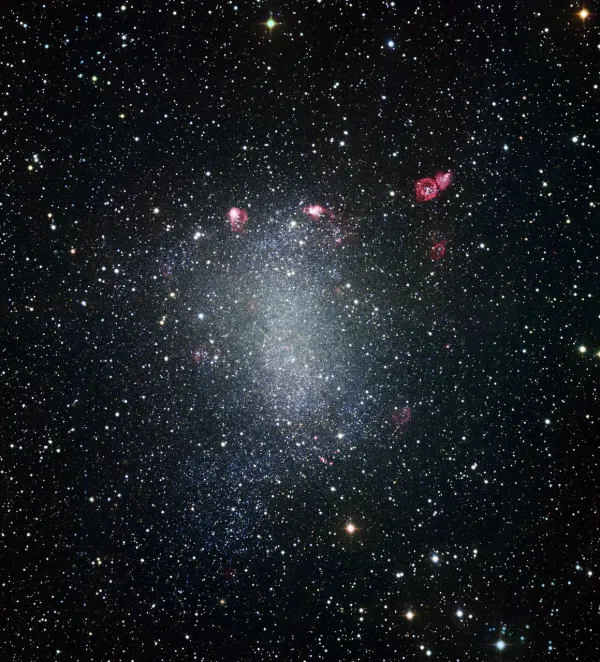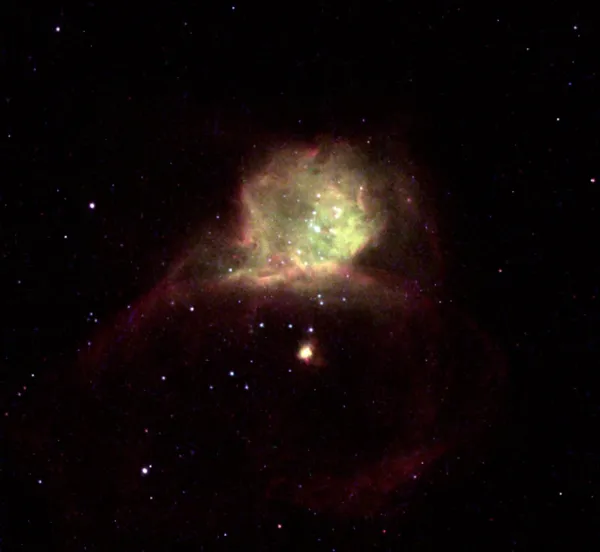Barnards Galaxy (NGC 6822)

History
This irregular dwarf galaxy was discovered on 17 August 1884 by American astronomer Edward Emerson Barnard using the 6 inch Cook refractor at Vanderbilt Observatory in Nashville, Tennessee. Barnard's galaxy was recorded as NGC 6822 by Dreyer in his «New General Catalogue of Nebulae and Clusters of Stars», published in 1888. Due to a series of confusions with later observations by Herbert Howe and Max Wolf, who used larger telescopes and did not see the galaxy as a whole, the same object was included in Dreyer's later «Index Catalogue» with the designations IC 1380 for a single H-II region and IC 4895 for the whole group of H-II regions in the galaxy. [313, 314, 315]
In 1925 Edwin Hubble published a study about NGC 6822 as a remote stellar system lying outside our galaxy. He identified ten H-II regions, which he designated with roman letters: Hubble I through X (IC 1308). [618]

Physical Properties
Like our Milky Way and the Andromeda galaxy, NGC 6822 belongs to the Local Group. At a distance of about 1.6 million light-years, it is closer than the Andromeda galaxy, but measures just 8000 light-years in diameter. Numerous H-II regions heated by young hot stars are evidence of active star formation. The stellar population is comparable to that of the Magellanic Clouds. The image in Fig. 1 was taken with four different filters (B, V, R, and Hα) and measures 34' x 35'. [4, 196, 274, 275]
Fig. 2 shows a Hubble Space Telescope image of the H-II region of the active star-forming region Hubble-X (IC 1308). This glowing cloud of gas is about 110 light-years across and hosts several thousand newly formed stars at its centre. Hubble-X is many times larger and brighter than the Orion Nebula, which is about the size of the small, poorly resolved nebula below. [276]
| Name | RA | Dec | Type | bMag | vMag | B-V | SB | Dim | PA | z | MD | Dreyer Description | Identification, Remarks |
|---|---|---|---|---|---|---|---|---|---|---|---|---|---|
| NGC 6822 | 19 44 56.6 | -14 48 23 | Gx (IBm) | 9.3 | 8.7 | 0.6 | 14.4 | 15.4 × 14.2 | 5 | -0.000190 | 0.500 | vF, L, E, dif | IC 4895; MCG -2-50-6; DDO 209; IRAS 19421-1455; Barnard's galaxy |
| IC 1308 | 19 45 05.2 | -14 43 17 | GxyP | 14.0 | 0.6 | 0.500 | eF, eS, lE, gbM, 6822 p 12s | LBN 83; part of N 6822 | |||||
| IC 4895 | 19 44 56.6 | -14 48 23 | dup | 9.3 | 8.7 | 0.6 | 14.4 | 15.4 × 14.2 | 5 | -0.000190 | 0.500 | Group of neb, 25' diam | NGC 6822; MCG -2-50-6; DDO 209; IRAS 19421-1455; Barnard's galaxy |
Finder Chart
Neighboring dwarf galaxy NGC 6822 is in the constellation Sagittarius, actually closer to Capricornus. It is slightly west of midpoint between α1/α2 Capricorni and υ Sagittarii. On 17 July it is in opposition to the Sun and crosses the meridian at local midnight. It is best seen from March to December. The apparent size of the dwarf galaxy and the low surface brightness assume a dark southern sky.
Visual Observation
400 mm Aperture: In the 21 mm Tele Vue Ethos (85x), only a large, diffuse hint of the dwarf galaxy NGC 6822 can be seen with indirect vision, barely brighter than the sky background. With O-III filter Hubble X (IC 1308) is not visible. — 400 mm f/4.5 Taurus Dobsonian, Gurnigel, 19. 8. 2023, Bernd Nies
762 mm Aperture: Barnard's Galaxy, NGC 6822, is only slightly brighter than the background. Its large and fluffy expanse can only be faintly perceived when the telescope is moved from the galaxy to the background. It seems that the elongated shape fills the field of view in length when using the TeleVue Ethos 13mm (193x). — 30" f/3.3 SlipStream Dobsonian, Hasliberg, 10. 8. 2024, SQM 21.28, Eduard von Bergen
